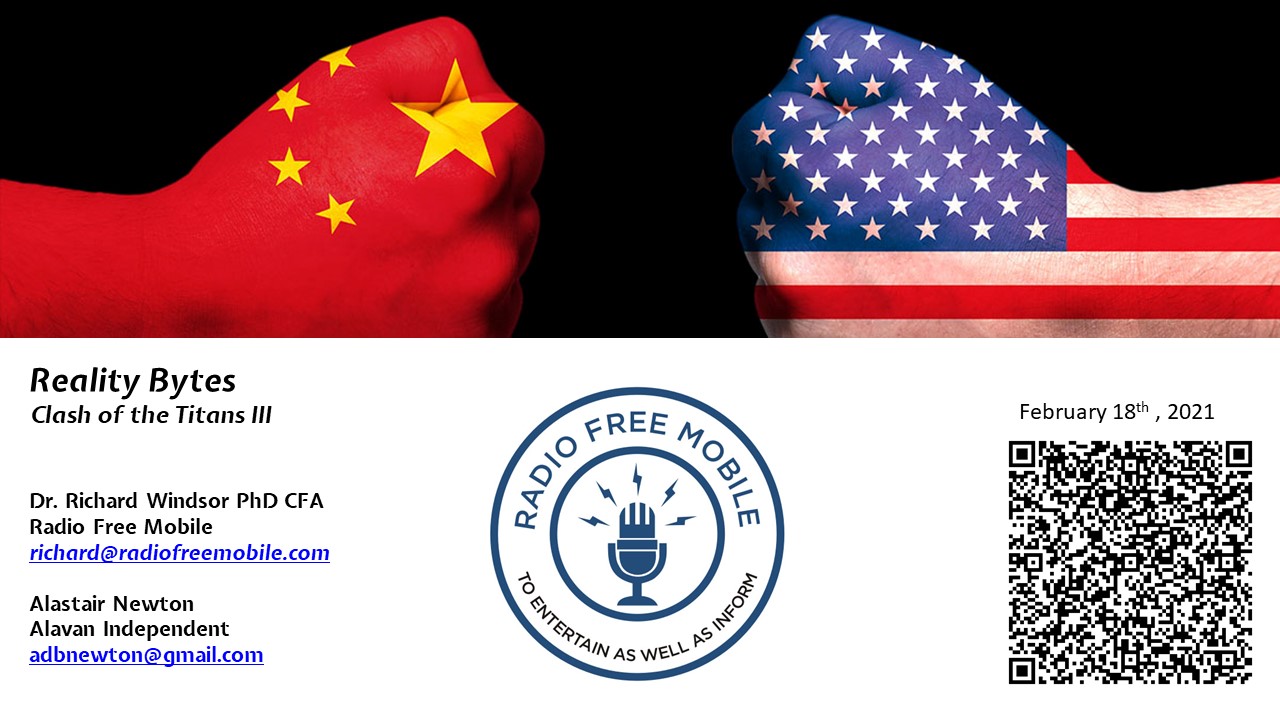February 18th 2021: RFM & Alavan Independent update their coverage of the USA / China technology war with the publication of Reality Bytes – Clash of the Titans III.
RFM subscribers will receive their own copy by email / secure download.
While the new administration is likely to take a softer tone with China in its discourse, we see little desire to relax the hawkish stance taken by the previous administration. There is still general agreement in Washington that China’s rise needs to be contained, but gaining support from Europe which does a lot of trade with China will be difficult. The issue of Taiwan is becoming more acute with China having abandoned strategic ambiguity raising the possibility of an invasion if it thinks that the USA will stand by and do nothing. Furthermore, Taiwan is where most of the world’s cutting edge semiconductors are manufactured greatly increasing its strategic importance. The USA has a large advantage in semiconductors and this is being used to apply pressure on China which is likely to remain dependent on US technology in this sector despite numerous efforts to reduce this dependency. However, in new and emerging technologies like AI, autonomous driving and supercomputing, China is running neck and neck with the USA and is even ahead in some areas. It is here where we see the wall being built which will result in lower long-term growth for all involved.
Politics – Alastair Newton
- Mean reversion. We think that the main direction of a Biden White House and a Democrat-controlled Congress will be to try to “normalise” foreign policy by reverting to the model which served it well through the second half of the 20th century. The risk is that the Administration will return to the Obama-era series of seminars where very little gets decided.
- Challenges, however, are significant and manifold. In particular, the US must adjust to an increasingly aggressive and expansionist China which is set on achieving its goal of being the world’s dominant power by 2050. Beijing will only play ball with the Biden Administration where it suits it and is already rattling the cage on various fronts to find out exactly how far it can go before the US pushes back.
- Bipartisan agreement on China in Washington should be supportive of Biden’s stated determination to take a tough line on China. But, despite support among key allies for his pro-democracy agenda, ensuring strong international action against Beijing will not be straightforward, especially not from the mercantile Europeans.
- Issue 1: Taiwan’s status has been long secured by ‘strategic ambiguity’. However, Xi Jinping has abandoned this in favour of forced reunification if necessary. And diminishing support for reunification in Taiwan itself (even before recent events in Hong Kong) means that his only realistic option for the foreseeable future is military force. Nevertheless, this would require an amphibious assault, among the most risky of all military manoeuvres, even if the US were not to intervene, and therefore not to be undertaken lightly. This leaves continuing attempts at coercion by Beijing as our base case for now, with the attendant serious risk of a miscalculation by one side or other.
- US Taiwan Policy: Washington is still clinging to strategic ambiguity despite its being past its ‘sell by’ date. Nevertheless, we do expect this to shift as the Administration firms up on the detail of its China policy (which it clearly has not as yet). A key may be Joe Biden’s “summit for democracy” late this year where an invitation to Taiwan would enrage Xi Jinping and force him to respond.
- Issue 2: Build the wall! ‘Strategic rivalry’ is currently most clearly being fought in the arena of the technology sector, in particular semiconductors where the US still has a big advantage. However, in other areas like AI, Supercomputing and autonomous driving, China competes head to head with the US raising the possibility of dual standards as each technology evolves. We see this as negative for long-term growth but inevitable as the rivalry looks set only to deepen into the long-term.
Technology – Richard Windsor
- Cold war. China and the USA are engaged in what is likely to be a long, cold drawn-out battle for technological supremacy. While this is not ideal and is detrimental to long-term growth, it is far better than a military conflict. The USA currently has the upper hand given its chokehold on the semiconductor industry but this will not last forever as there are plenty of areas where China competes on a level footing. China has raised the possibility of restricting the supply of rare earth metals again but there is no reason to think that will work any better than its abject failure in 2015.
- Semiconductor equipment is where war is currently being fought. China finds it almost impossible to manufacture these critical building blocks for technology hardware without using US technology, equipment and software. This is why the USA has pushed particularly hard in this area and the impact for those that have been placed on the entity list is likely to be very substantial indeed.
- Huawei and SMIC are the two companies that are the most directly affected and TSMC stopped all shipments to Huawei in September 2020 effectively cutting it off from cutting edge semiconductors. Huawei needs access to these in order to produce competitive smartphones meaning that when it runs out of the components it has in inventory, life will become very difficult. SMIC is also in great difficulty with no access to cutting edge manufacturing equipment. This means that it will unable to improve its 14nm process and there is little scope for it to migrate beyond that while the current situation persists. We see Huawei, in particular, being used as a political football in the much wider trade negotiation between China and the USA and it is on this basis that any relief will come.
- China’s semiconductors need to become self-sufficient in China’s view but the road to achieving this will be hard. There is a possibility to remove its dependency on Arm by migrating to RISC-V but this is much more difficult than it sounds. Recruiting staff from US semiconductor offices in China is not ideal and strategies to buy and relocate IP to China have been quickly closed down by Western authorities. The net result is that we think that China will be unable to meaningfully reduce its dependence on US technology in semiconductors, but its outlook in other areas is much more promising.
- AI and autonomous driving are emerging as two very important areas within the technology sector and in both of these, China is no slouch. RFM’s rating for AI has 3 of the top 5 global AI companies being Chinese and only one being from the USA. Autonomous driving is a similar story with 3 of the top 5 and 5 of the top 12 players all being headquartered in China.
- Supercomputing is a similar story where both the USA and China have taken very different approaches. The USA is using superconductors but China has built a massively paralleled optical circuit resulting in a computer that it claims is 380,000 faster than its American counterpart.
- Build the wall. It is in these new and emerging technologies where we see dual standards emerging. We think that semiconductors are a lost cause for China for no other reason than it started much too late. In the emerging areas, it is neck and neck with the rest of the world and dual standards look inevitable. Networks that are isolated from one another result in much lower overall value creation than if they are part of a single larger network. For this reason, we think that the long-term growth in this sector will be much lower as a result.









Autonomous Autos – Hard Ec ...
31 March 2025